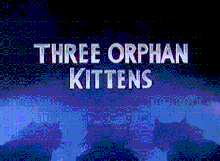Three Orphan Kittens
| Three Orphan Kittens | |
|---|---|
| Silly Symphonies series | |

A screenshot of the film's title card
|
|
| Directed by | David Hand |
| Produced by | Walt Disney |
| Story by | Bill Cottrell |
| Music by | Frank Churchill |
| Animation by |
Ken Anderson Bob Wickersham |
| Layouts by | Ken Anderson |
| Studio | Walt Disney Productions |
| Distributed by | United Artists |
| Release date(s) | October 26, 1935 (USA) |
| Color process | Technicolor |
| Running time | 9 min |
| Country | United States |
| Language | English |
| Preceded by | Music Land |
| Followed by | Cock o' the Walk |
Three Orphan Kittens is a 1935 animated short film in the Silly Symphonies series produced by Walt Disney Productions. It was the winner of the 1935 Academy Award for Best Short Subject (Cartoons). It was followed in 1936 by a sequel, More Kittens.
The film tells the story of three kittens (one black, one orange and one grey) and their adventures in a house. It begins with the kittens left out in the snow. They then notice the house nearby and enter it for shelter. They arrive at its kitchen, and begin to play there after the house's African-American housekeeper (possibly a prototype version of Mammy Two-Shoes) has finished preparing a meal. After more playing in various areas of the house, the film switches its focus to one particular kitten, the black one, who is chasing a feather and eventually ends up on a piano keyboard. The kitten starts to play with the feather walking down the piano keyboard and the feather lands on the 'on' switch with the kitten presses and the then-revealed pianola begins to play; ironically it is playing a variation of "Kitten On The Keys" a song composed by Zez Confrey in 1921. The other two kittens rejoin the first and play around the pianola. When the pianola finishes its song, the kittens leave it and are caught by the housekeeper. As she prepares to throw them out, she is stopped by a little girl (possibly version of Nancy), who decides to adopt the kittens.
The film was produced as an entry in Disney's Silly Symphonies series. At the time, the Symphonies were being used as a vehicle to test the techniques which would be used in Snow White and the Seven Dwarfs and to provide an informal on-the-job training program to prepare artists for the elaborate scenes that would be included in the studio's feature-length productions. As such, the films were intended to focus on the characters, which were intended to be cute, rather than a particularly developed narrative. It was directed by David Hand, who would later direct Snow White, and animated by Ken Anderson. Like all Silly Symphonies made after 1932, it was produced in three-strip Technicolor. The film was copyrighted on November 20, 1935, nearly a month after its release.
...
Wikipedia
